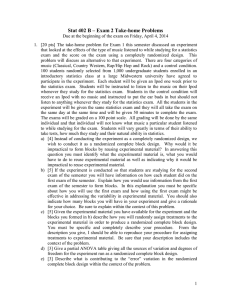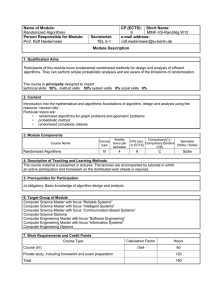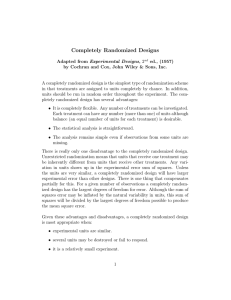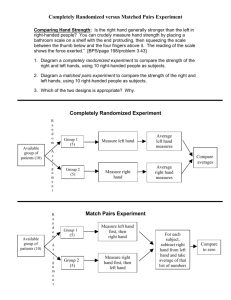Stat 402 B – Exam 2 Take-home Problems
advertisement
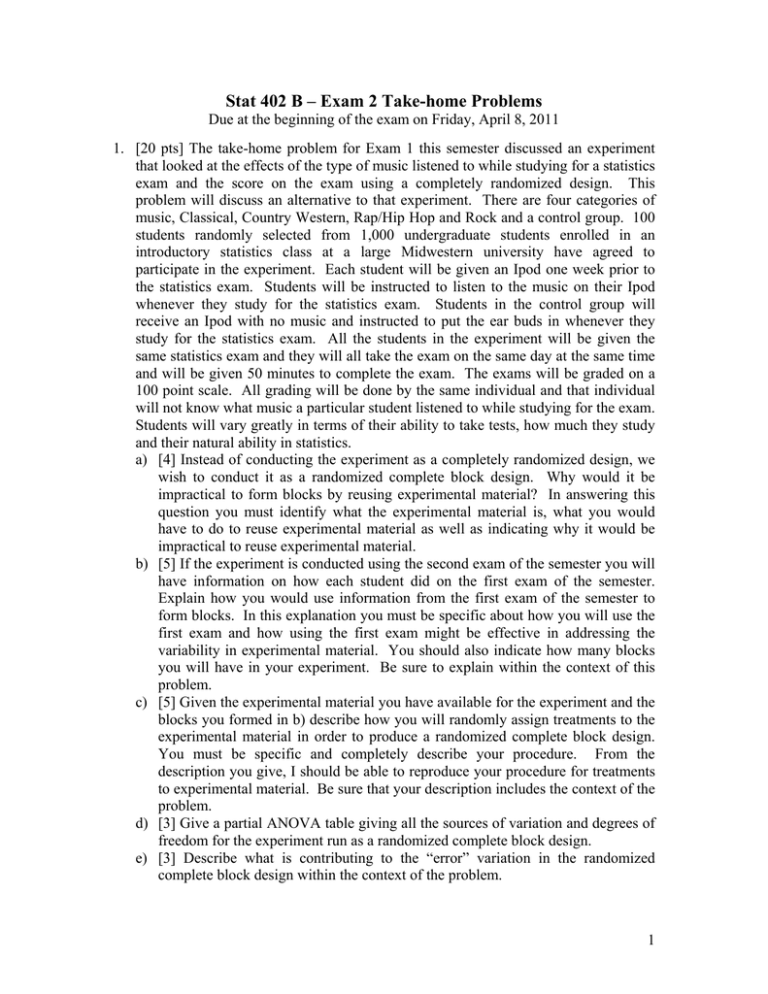
Stat 402 B – Exam 2 Take-home Problems Due at the beginning of the exam on Friday, April 8, 2011 1. [20 pts] The take-home problem for Exam 1 this semester discussed an experiment that looked at the effects of the type of music listened to while studying for a statistics exam and the score on the exam using a completely randomized design. This problem will discuss an alternative to that experiment. There are four categories of music, Classical, Country Western, Rap/Hip Hop and Rock and a control group. 100 students randomly selected from 1,000 undergraduate students enrolled in an introductory statistics class at a large Midwestern university have agreed to participate in the experiment. Each student will be given an Ipod one week prior to the statistics exam. Students will be instructed to listen to the music on their Ipod whenever they study for the statistics exam. Students in the control group will receive an Ipod with no music and instructed to put the ear buds in whenever they study for the statistics exam. All the students in the experiment will be given the same statistics exam and they will all take the exam on the same day at the same time and will be given 50 minutes to complete the exam. The exams will be graded on a 100 point scale. All grading will be done by the same individual and that individual will not know what music a particular student listened to while studying for the exam. Students will vary greatly in terms of their ability to take tests, how much they study and their natural ability in statistics. a) [4] Instead of conducting the experiment as a completely randomized design, we wish to conduct it as a randomized complete block design. Why would it be impractical to form blocks by reusing experimental material? In answering this question you must identify what the experimental material is, what you would have to do to reuse experimental material as well as indicating why it would be impractical to reuse experimental material. b) [5] If the experiment is conducted using the second exam of the semester you will have information on how each student did on the first exam of the semester. Explain how you would use information from the first exam of the semester to form blocks. In this explanation you must be specific about how you will use the first exam and how using the first exam might be effective in addressing the variability in experimental material. You should also indicate how many blocks you will have in your experiment. Be sure to explain within the context of this problem. c) [5] Given the experimental material you have available for the experiment and the blocks you formed in b) describe how you will randomly assign treatments to the experimental material in order to produce a randomized complete block design. You must be specific and completely describe your procedure. From the description you give, I should be able to reproduce your procedure for treatments to experimental material. Be sure that your description includes the context of the problem. d) [3] Give a partial ANOVA table giving all the sources of variation and degrees of freedom for the experiment run as a randomized complete block design. e) [3] Describe what is contributing to the “error” variation in the randomized complete block design within the context of the problem. 1 2. [10 pts] A new type of fish food has become available for salmon raised on fish farms. Your task is to design an experiment to compare the weight gain of salmon raised over a six-month period on the new and old types of food. Eighty salmon that are similar in size and weight are available for the experiment. All salmon should be used in the experiment. There are eight large tanks in a room that has a considerable temperature gradient. Specifically, tanks on the north side of the room tend to be much colder than those on the south side. Additionally, because the doors are opened frequently, more cold air can enter the room by the doors than by the windows. The arrangement of tanks is shown on the diagram below. The same amount of food will be given to each tank each day. The room and the tanks are available to do one feeding experiment. a) [3] What are the response, conditions and experimental units? b) [4] Describe a design for this experiment that takes into account the temperature gradient in the room. Be specific. Be sure to describe how you will use randomization in your experiment. c) [3] Give an ANOVA table indicating all sources of variability and degrees of freedom associated with each source. 2
